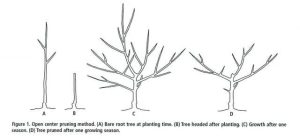Nature prunes ruthlessly using shade, wind, fruit overload, ice and snow. These natural operations often destroy the tree, allowing decay to enter. Human efforts can enhance beauty, form, and fruit production, strengthen structure and prevent wounds and disease, ultimately extending the tree’s health and life.
Proper pruning shapes the tree to allow good sun exposure. This encourages optimal photosynthesis. Sunlight actually strengthens the fruiting wood; shading inhibits growth. The “open center” and “central leader” systems are two pruning methods the gardener can choose.
“Open center” is designed to produce a smaller tree. The fruit can be harvested without a ladder and pruning is done from the ground. Three to four strong scaffold (or main structural) branches are chosen, evenly distributed around the trunk. The total height is below 6 feet. This creates a more open tree, increasing fruit quality by allowing greater light penetration and air circulation, which discourages disease and insects.
“Central leader” produces a taller tree, allowing a larger harvest and more shade. A central branch becomes dominant, and the lower scaffolding branches are chosen to grow evenly below and around the leader.
Once the system is decided upon, pruning should be done in February or March after severe winter weather is over. Never prune on a wet day as fungal disease spores are spread by water. Tools should be sharp, of high quality, so that cuts will be clean (not tearing the wood jaggedly).
Cuts made at the main trunk are called thinning. The branch should be removed just above the wrinkled “shoulder” where it attaches, making the smallest cut possible. Wounds left after the cut should not be covered with ointment or paint. Natural drying seals the tree from infection.
Cuts, made at a lateral outward-facing bud, are called heading back, and encourage growth in a specific direction. Each bud allowed to remain will swell into growth, ultimately becoming a branch. This determines which way growth proceeds. It is important to cut just above the bud, leaving only ¼ inch. Otherwise, a dead stub will develop which is unsightly and may allow entrance of disease.
Pruning is essential for quality fruit. Sun-exposed wood produces the best fruit. Some fruit is produced on longer-lived spurs or branches. Cherry, European plum and pear trees bear on long- lived spurs, so retain most spurs for fruiting. They should be lightly pruned which means removing approximately 20% of the branches. Apple trees can be pruned a bit more. Apricot, peaches, nectarine, fig and Japanese plum bear on one-year growth, so pruning can be heavier, up to 50%. If a tree lacks vigor, it should be heavily pruned while dormant to encourage new growth. If a tree is overly vigorous, pruning can be done in the summer in addition to winter to reduce the volume of leaf growth.
Resist the urge to spray pesticides on your fruit trees since beneficial insects will be destroyed before pollination can occur. Bees are an integral part of the life cycle of flower to fruit. Now is the time to spray the entire tree with dormant oil to suffocate over-wintering pests, but don’t spray when temperatures are below 40 degrees.
If you would like to see a demonstration on pruning, the Master Gardener’s demonstration garden will be open for a lesson on tree pruning and soil preparation for spring planting on February 6, 2016. The demo garden is located at Cassina High School, 251 S. Baretta St, Sonora, Ca.
Julie Segerstrom is a University of California Cooperative Extension Master Gardener of Tuolumne County.


